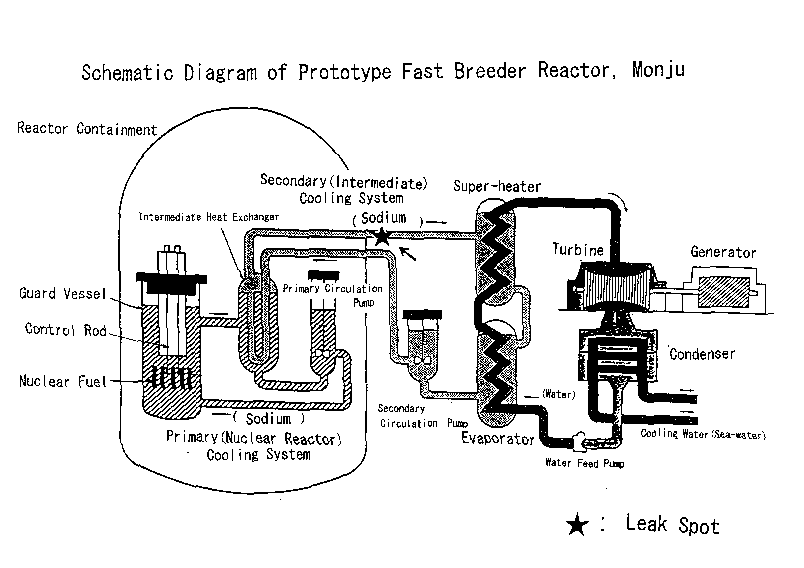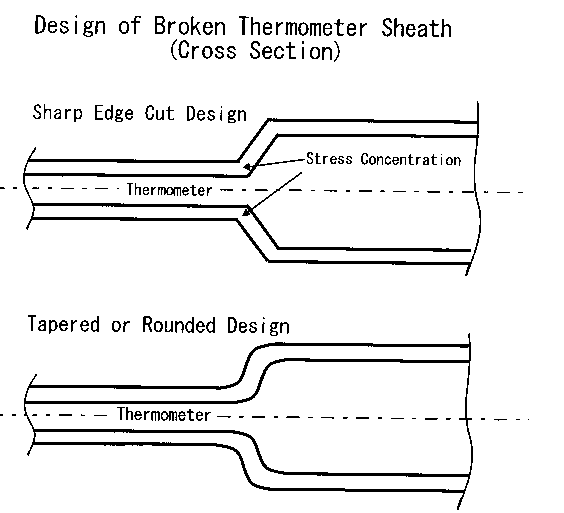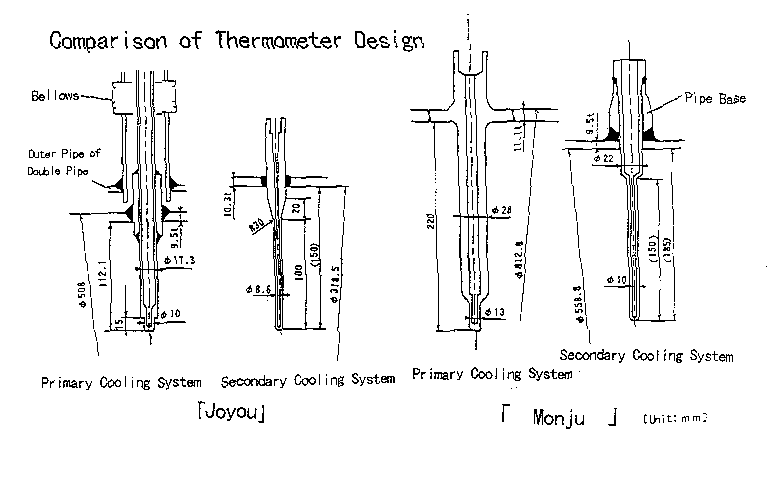Case 1: Fire by Sodium Coolant Leak at Prototype Fast Breeder Reactor, Monju
Case 1 of Teaching Case Studies of Accidents in Nuclear Energy Development in Japan describes a fire caused by a massive sodium coolant leak at the Monju fast breeder reactor.
This case is an excerpt from Three Teaching Case Studies of Accidents in Nuclear Energy Development in Japan.
On December 8, 1995, a prototype fast breeder reactor, Monju, located in Tsuruga City, 350km west of Tokyo, was operating at 40% power
Figure 1:
The sheath was found to have been broken by following design errors such as,
- The sharp cut edge design of the sheath as shown in Fig. 2, which caused stress concentration and breakage,
- Neglect of newly established mechanical design analysis of vibration of the sheath parallel to the sodium flow and
- The IH company's failure to consider the fact that liquid sodium is 120 times more heat conductive than water and to use the another contractor's (the H company's) better and simpler design for those of the primary heat exchangers. See Fig. 3.
Figure 2:
Figure 3:
The PNC had been always asked by neighbors as well as anti-nuclear organizations whether their nuclear reactors are absolutely safe. They felt constrained to reply "yes" under the circumstances. Under these conditions, the initial cover up of hiding the videotapes taken at the site and of showing them after editing and the PNC's delay (of about one hour) in informing the neighboring community agencies of the accident ignited a fierce protest by the public.
This example teaches the students following lessons:
Influence of quality of engineering works
The small design errors in the cheap component which may come from lack of competence and care of designers in the IH Company and JNC as the user, caused the accident.
The cover up of the video tapes and delay in informing others of the accident
The cover up decision was made by managers including ex-engineers. When I asked our students in the class if they do the same under the situations, one-third of them said they might although they think it is a very stupid act. The delay of informing the accidents is mainly due to lack of the system oversight and to the bureaucracy within the JNC organization. These caused loss of public trust in general and have delayed the several tens of billion dollar project at least 6 years, although the government wants to resume the project as soon as possible.
Importance of professional work in accidents
The manuals to handle this kind of the accident were not made although they had some for other types of sodium coolant leakage. Manuals are necessary and useful especially in simple operation. But in accidents like this, which no one had expected and which are generally much more complex than those anticipated in manuals, professional judgments are much more important and necessary. In this case, the air conditioners, which had not been shut down, continued to supply fresh air to the fire.
Learning from past experience
The earlier experimental fast breeder reactor, Joyo, which was designed based on practical experiences by the engineers of previous generation, had not had any serious sodium leak accident for 18 years since its start of the operation in 1977. Most of these engineers, however, were retired or moved to other job as time passed. New generation of engineers might have thought it easy to handle. This is the problem of transferring and learning engineering experience and skills between generations.
Responsibility of managers (ex-engineers) to the public
Engineers know "nothing is absolutely safe". But sometimes political pressure forces managers to say yes to the public on the absolute safety question. But the more realistic question form the public is that the engineers make a maximum professional effort to eliminate the safety hazard. Engineers should have realized the responsibility of clarifying the situation. After a long discussion on the safety including the following two accidents, the Committee of the Nuclear Safety Commission in Japan formally declared in "The White Paper 2000 on Safety of Nuclear Energy (in Japanese)" approved on March 27, 2001 that "none can say nuclear energy is absolutely safe".
Author: Hiroshi Iino, Kanazawa Institute of Technology, Japan.
Presented at the OEC International Conference on Ethics in Engineering and Computer Science, March 1999.




